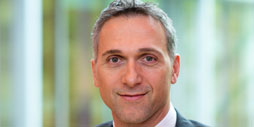
23 July 2021 – Signify's CEO Eric Rondolat urges European leaders to deliver a Fit for 55 package that can help European business achieve the continent’s climate goals without losing competitiveness.
As business leaders, we know that transformative action starts with a strong commitment, followed by a concrete action plan and, underpinning it all, the focus and resilience to see it through. With global temperatures rising at unprecedented levels, it is now up to our political leaders to take on the greatest leadership challenge of all.
Last year, the European Commission signed off on its commitment: at least 55% reduction in emissions by the year 2030. This month, this ambition was backed up by Fit for 55, a package of new and revised initiatives that creates the legislative framework to deliver on the EU’s promise to its people. The ambition does not change, but now has the support of climate and energy laws to safeguard its progress. And with a 55% emissions reduction target considered rather modest, our road to reaching it must at least be robust. Ensuring that we remain on a rock-solid path to this target is the task of Fit for 55.
“We can see around us that while companies and industry sectors are willing to act, they need help. They need to know that changes can be made without losing economic competitiveness, that they can invest in future growth and innovation, and create jobs that will last."
Predictably, this package has not been pleasing to all. For those frustrated with the political pace, and I am often one of them, this may seem like a lot more talk. But we can see around us that while companies and industry sectors are willing to act, they need help. They need to know that changes can be made without losing economic competitiveness, that they can invest in future growth and innovation, and create jobs that will last. They need a firm statement that Europe’s economic recovery will take an unequivocally sustainable direction.
To see how this can play out, we can look to the incredible potential for energy renovation in our built environment. Europe’s aging buildings are our biggest sinks of energy consumption, accounting for 40% of energy consumed and 36% of energy-related greenhouse gas emissions. Yet only 1% of buildings undergo energy efficient renovation per year. This glacial pace cannot continue when the rewards are so tangibly evident in emissions reductions, infrastructure benefits, and job creation across the EU.
One of the quickest wins within energy renovation is lighting. Replacing the EU’s 2.3 billion conventional light points with energy-efficient LED would save €40 billion per year and eliminate 50.9 million tonnes of CO2 emissions per year. It’s a quick, non-intrusive intervention that benefits everyone, with an unparalleled payback in speed, cost, and effectiveness.
Building renovation is also a major driver of post-pandemic economic recovery. Every €1 million spent on renovation creates 18 local jobs in the EU. An increase in our renovation rate to 3% will create 1.5 million jobs across Europe, with most of the benefit going to the local SMEs that make up more than 90% of companies in the building sector.
Despite this, barriers remain, from initiating renovations to accessing finance and completing projects. The European Commission’s Renovation Wave strategy addresses pain points throughout the process with regulation, funding, and technical assistance to eliminate barriers and create homes, workplaces and public spaces that are energy efficient, comfortable, and safe for our health and wellbeing. This is further supported by updates to the Energy Efficiency Directive as part of Fit for 55, which include a much-needed mandatory target of at least 3% annual energy efficiency improvement rate in all public buildings.
“Crucially, we need to close the gap between the businesses and sectors that now show sustainable leadership, and those that remain dependent on polluting technologies and fossil fuels.”
Ahead of the Fit for 55 announcement, I joined leading businesses, investors and networks across Europe in signing an open letter calling for the EU to ramp up its climate ambition and laying out ten principles for an effective and coherent package of legislation in the run up to COP26. As industry leaders, we have made our own bold climate commitments and followed them through, proving that climate action and economic prosperity can go hand in hand. Crucially, we need to close the gap between the businesses and sectors that now show sustainable leadership, and those that remain dependent on polluting technologies and fossil fuels. Aligning economic stimulus with climate action is the only way we can guarantee a livable and prosperous Europe for the next generation and beyond.

